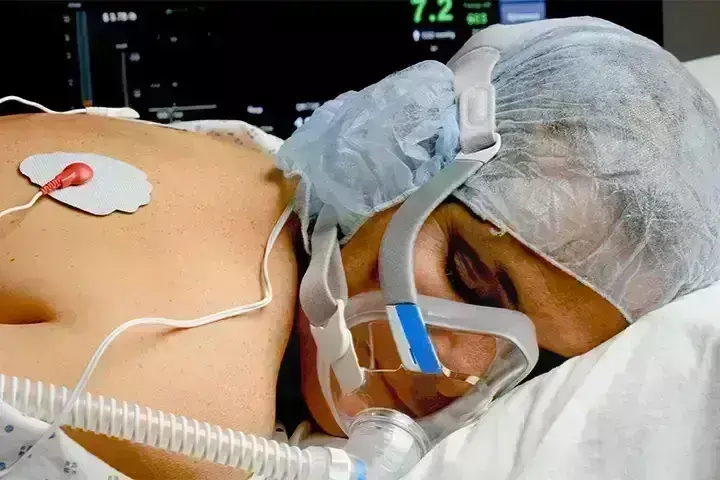- Home
- Medical news & Guidelines
- Anesthesiology
- Cardiology and CTVS
- Critical Care
- Dentistry
- Dermatology
- Diabetes and Endocrinology
- ENT
- Gastroenterology
- Medicine
- Nephrology
- Neurology
- Obstretics-Gynaecology
- Oncology
- Ophthalmology
- Orthopaedics
- Pediatrics-Neonatology
- Psychiatry
- Pulmonology
- Radiology
- Surgery
- Urology
- Laboratory Medicine
- Diet
- Nursing
- Paramedical
- Physiotherapy
- Health news
- Fact Check
- Bone Health Fact Check
- Brain Health Fact Check
- Cancer Related Fact Check
- Child Care Fact Check
- Dental and oral health fact check
- Diabetes and metabolic health fact check
- Diet and Nutrition Fact Check
- Eye and ENT Care Fact Check
- Fitness fact check
- Gut health fact check
- Heart health fact check
- Kidney health fact check
- Medical education fact check
- Men's health fact check
- Respiratory fact check
- Skin and hair care fact check
- Vaccine and Immunization fact check
- Women's health fact check
- AYUSH
- State News
- Andaman and Nicobar Islands
- Andhra Pradesh
- Arunachal Pradesh
- Assam
- Bihar
- Chandigarh
- Chattisgarh
- Dadra and Nagar Haveli
- Daman and Diu
- Delhi
- Goa
- Gujarat
- Haryana
- Himachal Pradesh
- Jammu & Kashmir
- Jharkhand
- Karnataka
- Kerala
- Ladakh
- Lakshadweep
- Madhya Pradesh
- Maharashtra
- Manipur
- Meghalaya
- Mizoram
- Nagaland
- Odisha
- Puducherry
- Punjab
- Rajasthan
- Sikkim
- Tamil Nadu
- Telangana
- Tripura
- Uttar Pradesh
- Uttrakhand
- West Bengal
- Medical Education
- Industry
Early Changes in ROX Index Predicts Treatment Failure After Awake Prone Positioning in Acute Respiratory Failure: Study

A recent groundbreaking study conducted on COVID-19 patients found the predictive value of the respiratory rate-oxygenation (ROX) index in acute respiratory failure. The study found that changes in the ROX index after the first awake-prone positioning session led to intubation and death as per the findings published in the journal Intensive Care Medicine.
Proning is a method of treating intubated and sedated patients by making them lie on their stomachs. During the COVID-19 pandemic, many physicians found beneficial effects of treating individuals in prone positions. However, the accurate physiological parameters that have to be monitored after a session of awake-prone positioning in individuals with acute respiratory failure are not known. Hence, researchers conducted a study to identify the early physiologic changes that are linked to the need for invasive mechanical ventilation or death in patients with acute respiratory failure after the first session of awake-prone positioning.
a secondary analysis of a prospective cohort study was carried out by including adult patients with acute respiratory failure related to coronavirus disease 2019 (COVID-19) treated with awake prone positioning. the association between relative changes in physiological variables such as oxygenation, respiratory rate, pCO2, and respiratory rate-oxygenation [ROX] index was assessed within the first 6 h of the first awake prone positioning session with treatment failure. A treatment was considered to be a failure when there arose a necessity for endotracheal intubation and/or death within 7 days.
Findings:
- About 244 patients that included 70 females (29%), with a mean age of 60 were included.
- Nearly Seventy-one (29%) patients experienced awake-prone positioning failure.
- ROX index was found to be the main physiologic predictor.
- Patients with treatment failure had lower mean [SD] ROX index at baseline [5 (1.4) versus 6.6 (2.2), p < 0.0001] and within 6 h of prone positioning [5.6 (1.7) versus 8.7 (2.8), p < 0.0001].
- After adjusting for baseline characteristics and severity, a relative increase of the ROX index compared to baseline was associated with lower odds of failure.
Thus, the study concluded that the ROX index was the main predictive factor for intubation and mortality in individuals treated by awake-prone positioning.
Further reading: Olmos M, Esperatti M, Fuentes N, et al. Early physiologic changes after awake prone positioning predict clinical outcomes in patients with acute hypoxemic respiratory failure. Intensive Care Med. Published online November 14, 2024. doi:10.1007/s00134-024-07690-3
BDS, MDS
Dr.Niharika Harsha B (BDS,MDS) completed her BDS from Govt Dental College, Hyderabad and MDS from Dr.NTR University of health sciences(Now Kaloji Rao University). She has 4 years of private dental practice and worked for 2 years as Consultant Oral Radiologist at a Dental Imaging Centre in Hyderabad. She worked as Research Assistant and scientific writer in the development of Oral Anti cancer screening device with her seniors. She has a deep intriguing wish in writing highly engaging, captivating and informative medical content for a wider audience. She can be contacted at editorial@medicaldialogues.in.
Dr Kamal Kant Kohli-MBBS, DTCD- a chest specialist with more than 30 years of practice and a flair for writing clinical articles, Dr Kamal Kant Kohli joined Medical Dialogues as a Chief Editor of Medical News. Besides writing articles, as an editor, he proofreads and verifies all the medical content published on Medical Dialogues including those coming from journals, studies,medical conferences,guidelines etc. Email: drkohli@medicaldialogues.in. Contact no. 011-43720751




